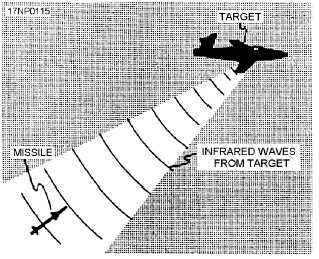PASSIVE.—In the passive homing system (fig.
3-5), the directing intelligence is received from the
target. Examples of passive homing include homing on
a source of infrared rays (such as the hot exhaust of jet
aircraft) or radar signals (such as those transmitted by
ground radar installations). Like active homing, passive
homing is completely independent of the launching
aircraft. The missile receiver receives signals generated
by the target and then the missile control section
functions in the same manner as previously discussed.
REVIEW NUMBER 1 ANSWERS
A1.
If a guided missile is traveling at Mach 1, it is
traveling at approximately 766 miles per
hour.
A2.
A missile traveling at Mach 3 is traveling at
supersonic speeds.
A3.
The two types of guided missiles are service
and nonservice guided missiles.
A4.
The two types of guided missiles used in naval
aviation are air-to-air and air-to-surface
guided missiles.
A5.
The first letter of a missile designation
describes the missile's launch environment.
A6.
The missile designation ATM stands for an
air-launched training guided missile.
A7.
The serial number in an assembled missile is
usually found on the leading component.
A8.
The color codes on guided missiles identify
the explosive hazard in the missile com-
ponent.
Armament Section
The armament system contains the payload
(explosives), fuzing, safety and arming (S&A) devices,
and target-detecting devices (TDDs).
PAYLOAD.—The payload is the element or part of
the missile that does what a particular missile is
launched to do. The payload is usually considered the
explosive charge, and is carried in the warhead of the
missile. High-explosive warheads used in air-to-air
guided missiles contain a rather small explosive charge,
generally 10 to 18 pounds of H-6, HBX, or PBX high
explosives. The payload contained in high-explosive
warheads used in air-to-surface guided missiles varies
widely, even within specific missile types, depending
on the specific mission. Large payloads, ranging up to
450 pounds, are common. Comp B and H-6 are typical
explosives used in a payload.
Most exercise warheads used with guided missiles
are pyrotechnic signaling devices. They signal fuze
functioning by a brilliant flash, by smoke, or both.
Exercise warheads frequently contain high explosives,
which vary from live fuzes and boosters to self-destruct
charges that can contain as much as 5 pounds of high
explosive.
FUZING.—The fuzing and firing system is
normally located in or next to the missile's warhead
section. It includes those devices and arrangements that
cause the missile's payload to function in proper
relation to the target. The system consists of a fuze, a
safety and arming (S&A) device, a target-detecting
device (TDD), or a combination of these devices.
There are two general types of fuzes used in guided
missiles—proximity
fuzes
and
contact
fuzes.
Acceleration forces upon missile launching arm both
fuzes. Arming is usually delayed until the fuze is
subjected to a given level of accelerating force for a
specified amount of time. In the contact fuze, the force
of impact closes a firing switch within the fuze to
complete the firing circuit, detonating the warhead.
Where proximity fuzing is used, the firing action is very
similar to the action of proximity fuzes used with
bombs and rockets.
SAFETY AND ARMING (S&A) DEVICES.—
S&A devices are electromechanical, explosive control
devices. They maintain the explosive train of a fuzing
system in a safe (unaligned) condition until certain
requirements of acceleration are met after the missile is
fired.
3-6
Figure 3-5.—Passive homing system.

